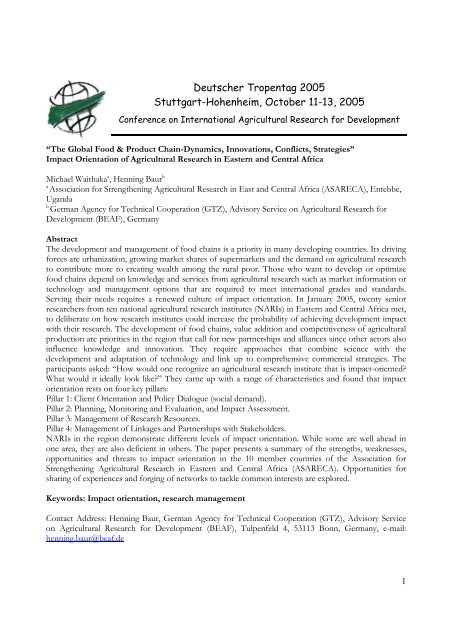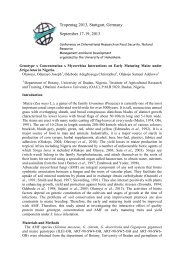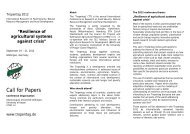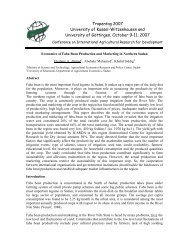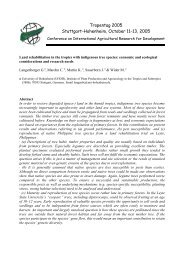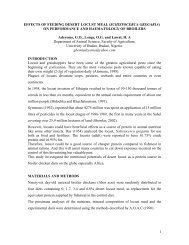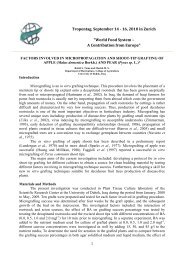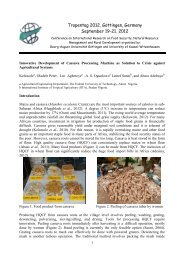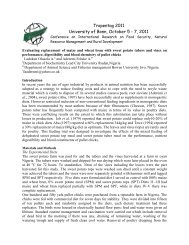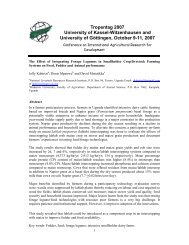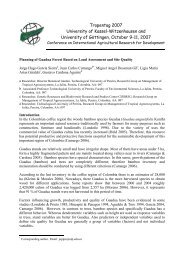Impact Orientation of Agricultural Research in Eastern ... - Tropentag
Impact Orientation of Agricultural Research in Eastern ... - Tropentag
Impact Orientation of Agricultural Research in Eastern ... - Tropentag
You also want an ePaper? Increase the reach of your titles
YUMPU automatically turns print PDFs into web optimized ePapers that Google loves.
Deutscher <strong>Tropentag</strong> 2005Stuttgart-Hohenheim, October 11-13, 2005Conference on International <strong>Agricultural</strong> <strong>Research</strong> for Development“The Global Food & Product Cha<strong>in</strong>-Dynamics, Innovations, Conflicts, Strategies”<strong>Impact</strong> <strong>Orientation</strong> <strong>of</strong> <strong>Agricultural</strong> <strong>Research</strong> <strong>in</strong> <strong>Eastern</strong> and Central AfricaMichael Waithaka a , Henn<strong>in</strong>g Baur baAssociation for Strengthen<strong>in</strong>g <strong>Agricultural</strong> <strong>Research</strong> <strong>in</strong> East and Central Africa (ASARECA), Entebbe,UgandabGerman Agency for Technical Cooperation (GTZ), Advisory Service on <strong>Agricultural</strong> <strong>Research</strong> forDevelopment (BEAF), GermanyAbstractThe development and management <strong>of</strong> food cha<strong>in</strong>s is a priority <strong>in</strong> many develop<strong>in</strong>g countries. Its driv<strong>in</strong>gforces are urbanization, grow<strong>in</strong>g market shares <strong>of</strong> supermarkets and the demand on agricultural researchto contribute more to creat<strong>in</strong>g wealth among the rural poor. Those who want to develop or optimizefood cha<strong>in</strong>s depend on knowledge and services from agricultural research such as market <strong>in</strong>formation ortechnology and management options that are required to meet <strong>in</strong>ternational grades and standards.Serv<strong>in</strong>g their needs requires a renewed culture <strong>of</strong> impact orientation. In January 2005, twenty seniorresearchers from ten national agricultural research <strong>in</strong>stitutes (NARIs) <strong>in</strong> <strong>Eastern</strong> and Central Africa met,to deliberate on how research <strong>in</strong>stitutes could <strong>in</strong>crease the probability <strong>of</strong> achiev<strong>in</strong>g development impactwith their research. The development <strong>of</strong> food cha<strong>in</strong>s, value addition and competitiveness <strong>of</strong> agriculturalproduction are priorities <strong>in</strong> the region that call for new partnerships and alliances s<strong>in</strong>ce other actors also<strong>in</strong>fluence knowledge and <strong>in</strong>novation. They require approaches that comb<strong>in</strong>e science with thedevelopment and adaptation <strong>of</strong> technology and l<strong>in</strong>k up to comprehensive commercial strategies. Theparticipants asked: “How would one recognize an agricultural research <strong>in</strong>stitute that is impact-oriented?What would it ideally look like?” They came up with a range <strong>of</strong> characteristics and found that impactorientation rests on four key pillars:Pillar 1: Client <strong>Orientation</strong> and Policy Dialogue (social demand).Pillar 2: Plann<strong>in</strong>g, Monitor<strong>in</strong>g and Evaluation, and <strong>Impact</strong> Assessment.Pillar 3: Management <strong>of</strong> <strong>Research</strong> Resources.Pillar 4: Management <strong>of</strong> L<strong>in</strong>kages and Partnerships with Stakeholders.NARIs <strong>in</strong> the region demonstrate different levels <strong>of</strong> impact orientation. While some are well ahead <strong>in</strong>one area, they are also deficient <strong>in</strong> others. The paper presents a summary <strong>of</strong> the strengths, weaknesses,opportunities and threats to impact orientation <strong>in</strong> the 10 member countries <strong>of</strong> the Association forStrengthen<strong>in</strong>g <strong>Agricultural</strong> <strong>Research</strong> <strong>in</strong> <strong>Eastern</strong> and Central Africa (ASARECA). Opportunities forshar<strong>in</strong>g <strong>of</strong> experiences and forg<strong>in</strong>g <strong>of</strong> networks to tackle common <strong>in</strong>terests are explored.Keywords: <strong>Impact</strong> orientation, research managementContact Address: Henn<strong>in</strong>g Baur, German Agency for Technical Cooperation (GTZ), Advisory Serviceon <strong>Agricultural</strong> <strong>Research</strong> for Development (BEAF), Tulpenfeld 4, 53113 Bonn, Germany, e-mail:henn<strong>in</strong>g.baur@beaf.de1
IntroductionThe development and management <strong>of</strong> food cha<strong>in</strong>s is a priority <strong>in</strong> many develop<strong>in</strong>g countries. Its driv<strong>in</strong>gforces are urbanization, grow<strong>in</strong>g market shares <strong>of</strong> supermarkets and the demand on agricultural researchto contribute more to creat<strong>in</strong>g wealth among the rural poor. Supermarkets are adopt<strong>in</strong>g <strong>in</strong>novations thatare reduc<strong>in</strong>g reliance on traditional wholesale markets and brokers to specialised and dedicatedwholesalers <strong>in</strong> new food cha<strong>in</strong>s who <strong>in</strong> turn contract smallholder farmers. To comply with thesedemands smallholder farmers <strong>in</strong>vest <strong>in</strong> technology and organize themselves <strong>in</strong> associations to aggregateproduce to meet volume requirements. To develop or optimize food cha<strong>in</strong>s, stakeholders are turn<strong>in</strong>g toagricultural research to provide knowledge and services <strong>in</strong> market <strong>in</strong>formation, technology andmanagement options that are required to meet <strong>in</strong>ternational grades and standards.Such demands are add<strong>in</strong>g to an already complex research agenda where research <strong>in</strong>stitutes are<strong>in</strong>creas<strong>in</strong>gly be<strong>in</strong>g required to demonstrate their contribution (impact) to development goals <strong>in</strong> generaland on poverty, hunger and malnutrition <strong>in</strong> particular (ASARECA, 2005). To demonstrate impact <strong>of</strong>agricultural research as a precondition for mobiliz<strong>in</strong>g additional <strong>in</strong>vestments, research <strong>in</strong>stitutes arebecom<strong>in</strong>g more impact orientated.The aspiration to become impact-oriented is challeng<strong>in</strong>g because the causal l<strong>in</strong>k between researchactivities and development impact is not straightforward. The path from the laboratory to the improvedlivelihood <strong>of</strong> farm families or urban consumers is very <strong>of</strong>ten long and w<strong>in</strong>d<strong>in</strong>g. Development impact issubject to and conditioned by many forces, both external and <strong>in</strong>ternal to the research <strong>in</strong>stitute. Andwhile a research <strong>in</strong>stitute can not <strong>in</strong>fluence many <strong>of</strong> these forces, it can <strong>in</strong>fluence some <strong>of</strong> them, if it hasa strong impact orientation.Pillars <strong>of</strong> impact orientationIn January 2005, 20 senior researchers from ten national agricultural research <strong>in</strong>stitutes (NARIs) <strong>in</strong><strong>Eastern</strong> and Central Africa met, to deliberate on how agricultural research <strong>in</strong>stitutes can <strong>in</strong>crease theprobability <strong>of</strong> achiev<strong>in</strong>g development impact with their research. They demonstrated strengths toimpact orientation are: greater <strong>in</strong>volvement <strong>of</strong> farmers <strong>in</strong> the research process; be<strong>in</strong>g responsive tomarket and client demands; new <strong>in</strong>itiatives towards impact orientation; existence <strong>of</strong> plann<strong>in</strong>g,monitor<strong>in</strong>g, and evaluation frameworks (Waithaka et al., 2005). Major weaknesses are <strong>in</strong>: poor<strong>in</strong>stitutionalization <strong>of</strong> impact assessments, plann<strong>in</strong>g, monitor<strong>in</strong>g and evaluation; low skills and capacity todeal with impact assessments; and poor l<strong>in</strong>kages between researchers and partners especially the privatesector. That some NARIs are advanced <strong>in</strong> areas that others are deficient <strong>in</strong> opens a great opportunityfor shar<strong>in</strong>g <strong>of</strong> experiences and forg<strong>in</strong>g <strong>of</strong> networks to tackle common <strong>in</strong>terests.It is becom<strong>in</strong>g clear that the development <strong>of</strong> food cha<strong>in</strong>s, value addition and competitiveness <strong>of</strong>agricultural production needs new partnerships and alliances with all actors who also <strong>in</strong>fluenceknowledge and <strong>in</strong>novation. These require approaches that comb<strong>in</strong>e science with the development andadaptation <strong>of</strong> technology and l<strong>in</strong>k up to comprehensive commercial strategies mak<strong>in</strong>g research moreresponsive to impact at developmental level. The participants asked: “How would one recognize anagricultural research <strong>in</strong>stitute that is impact-oriented? What would it ideally look like?” They came upwith a range <strong>of</strong> characteristics and found that impact orientation rests on four key pillars:1. Pillar 1: Client <strong>Orientation</strong> and Policy Dialogue (social demand)2. Pillar 2: Plann<strong>in</strong>g, Monitor<strong>in</strong>g and Evaluation, and <strong>Impact</strong> Assessment3. Pillar 3: Management <strong>of</strong> <strong>Research</strong> Resources4. Pillar 4: Management <strong>of</strong> L<strong>in</strong>kages and Partnerships with Stakeholders2
Pillar 1: Client <strong>Orientation</strong> and Policy Dialogue (social demand)Client orientation is important because policy makers, governments and donors who fund agriculturalresearch are <strong>in</strong>creas<strong>in</strong>gly ask<strong>in</strong>g for development impact. They want to know how much agriculturalresearch has contributed to raise people’s well be<strong>in</strong>g or the nation’s competitiveness or conservation <strong>of</strong>the county’s natural resources. To do that successfully, researchers envision how farmers will improvetheir well be<strong>in</strong>g as a result <strong>of</strong> apply<strong>in</strong>g research results or us<strong>in</strong>g research products and services e.g., byidentify<strong>in</strong>g impact pathways or by outcome mapp<strong>in</strong>g.<strong>Impact</strong> pathways describe the assumed l<strong>in</strong>e <strong>of</strong> causality between research <strong>in</strong>vestments anddevelopmental impacts (Hartwick et al., 2003). Their explicit formulation is important so as to captureall <strong>in</strong>termediate steps and actors whose <strong>in</strong>terventions help to transform research outputs <strong>in</strong>to outcomesand impacts. On the other hand, outcome mapp<strong>in</strong>g can be used to characterize and assess thecontributions research programs make to the achievement <strong>of</strong> development goals <strong>in</strong> terms <strong>of</strong> behaviouralchanges <strong>of</strong> important development partners (http://www.idrc.ca/evaluation ).Client-oriented researchers also observe the economic and political environment <strong>in</strong> which the research<strong>in</strong>stitution operates and understand the processes <strong>of</strong> agricultural <strong>in</strong>novation and economic development.These processes are driven by market forces, policies, and <strong>in</strong>stitutional change. <strong>Research</strong> <strong>in</strong>stitutesposition themselves with<strong>in</strong> this context by the choices they make after collect<strong>in</strong>g and <strong>in</strong>terpret<strong>in</strong>g<strong>in</strong>formation from the environment. They can <strong>in</strong>fluence their environment by present<strong>in</strong>g their f<strong>in</strong>d<strong>in</strong>gsand arguments, rais<strong>in</strong>g awareness for new problems and opportunities, and seek<strong>in</strong>g the support <strong>of</strong> other<strong>in</strong>terested parties.Pillar 2: Plann<strong>in</strong>g, Monitor<strong>in</strong>g and Evaluation, <strong>Impact</strong> AssessmentPlann<strong>in</strong>g, monitor<strong>in</strong>g and evaluation (PM&E), as well as impact assessment (IA) are essential activities tomanage the research process. In a rapidly chang<strong>in</strong>g technology, policy and economic environment,plann<strong>in</strong>g helps research <strong>in</strong>stitutes to anticipate research demands <strong>of</strong> stakeholders <strong>in</strong> the long and shortterm and to develop the necessary structure, resources and procedures to achieve them. Monitor<strong>in</strong>g andevaluation occur once the research process is <strong>in</strong> progress and help keep track <strong>of</strong> achievements and todraw lessons from experiences learnt. <strong>Impact</strong> assessment is carried out ex-ante when plann<strong>in</strong>g forresearch projects to assess potential benefits, for on-go<strong>in</strong>g work or ex–post after the completion <strong>of</strong>research projects to determ<strong>in</strong>e outcomes.PM&E and IA are important because they help to analyse and reflect periodically on whether theresearch <strong>in</strong>stitute is do<strong>in</strong>g the right th<strong>in</strong>gs and whether it is do<strong>in</strong>g these th<strong>in</strong>gs right also. They are alsothe primary activities for mak<strong>in</strong>g sense <strong>of</strong> new and/or unexpected trends, and for react<strong>in</strong>g to changes <strong>in</strong>society and <strong>in</strong> the market. PM&E needs to be done at different levels <strong>of</strong> the organisation and <strong>in</strong>different forms accord<strong>in</strong>g to specific requirements, i.e., participatory PM&E to respond to stakeholderneeds. Such results help to improve research strategies and programs if they successfully articulate thespecific concerns and aspirations <strong>of</strong> the stakeholders.Pillar 3: Management <strong>of</strong> <strong>Research</strong> ResourcesResources at the disposal <strong>of</strong> research <strong>in</strong>stitutes are funds which are sourced primarily from owngovernments or donors, human resources, capital equipment, and assets such as land and build<strong>in</strong>gs. Themost important resource is committed research staff that is capable <strong>of</strong> produc<strong>in</strong>g results and <strong>of</strong> judg<strong>in</strong>g3
the significance <strong>of</strong> their activities to clients and national development goals. This requires that researchmanagement pursues a comprehensive human resource strategy that is responsive to the chang<strong>in</strong>gdemands for research, is able to equip staff with necessary skills, motivate and reta<strong>in</strong> them <strong>in</strong> key areas.<strong>Research</strong> management must also raise and allocate f<strong>in</strong>ancial resources <strong>in</strong> such a way as to comply withrequirements emanat<strong>in</strong>g from research plans. In the face <strong>of</strong> decl<strong>in</strong><strong>in</strong>g research fund<strong>in</strong>g, researchmanagers need to identify and adjust to alternative fund<strong>in</strong>g mechanisms such as competitive grants andpartner<strong>in</strong>g with the private sector. Further, good research management depends on some k<strong>in</strong>d <strong>of</strong><strong>in</strong>formation management system and communicates effectively with stakeholders. This system shouldalso re<strong>in</strong>force <strong>in</strong>ternal self monitor<strong>in</strong>g and evaluation and give constant feedback to management.<strong>Research</strong> management should use the feedback to modify on-go<strong>in</strong>g activities, plan for future activitiesand create <strong>in</strong>centives and reward systems that re<strong>in</strong>force <strong>in</strong>novative activities that contribute to impactorientation.Pillar 4: Management <strong>of</strong> L<strong>in</strong>kages and Partnerships with StakeholdersSuccessful technology development and dissem<strong>in</strong>ation require collaboration with a wide range <strong>of</strong> peopleand organisations <strong>in</strong> the food cha<strong>in</strong> such as: users <strong>of</strong> technology such as farmers and theirrepresentatives, producer associations, other researchers, seed and other <strong>in</strong>put companies, traders,export promotion agencies and certification experts. This is important because at the present time, thereis little evidence that knowledge discovery and research skills would be the most limit<strong>in</strong>g factors forpoverty alleviation and agricultural wealth creation <strong>in</strong> Sub-Sahara Africa (Chema et al., 2003; ASARECA2005). However, access to knowledge and technology, their adjustment to local conditions as well aseconomically feasible implementation certa<strong>in</strong>ly are bottlenecks. Seen from this perspective, the adoption<strong>of</strong> a more comprehensive <strong>in</strong>novation approach appears to be more promis<strong>in</strong>g than a conventionalscientific research to extension to farmer approach – at least <strong>in</strong> the short and medium term.Such an approach <strong>in</strong>cludes wealth creation as a priority, helps us to better understand and analyse thevarious actors and networks <strong>in</strong> an <strong>in</strong>novation process that are jo<strong>in</strong>tly responsible for its ultimateoutcome and impact while reta<strong>in</strong><strong>in</strong>g a focus on the role <strong>of</strong> agricultural science and technology as adriv<strong>in</strong>g force <strong>in</strong> progress (ASARECA, 2005). It comb<strong>in</strong>es science with the development and/oradaptation <strong>of</strong> technology and is l<strong>in</strong>ked to comprehensive commercial strategies.ConclusionsIt is unlikely that research <strong>in</strong>stitutes can achieve impact at the development level if they are not impactoriented. This requires good understand<strong>in</strong>g <strong>of</strong> their clients and the environment they operate under, andstrong <strong>in</strong>volvement <strong>in</strong> policy dialogue to br<strong>in</strong>g out mean<strong>in</strong>gful changes. Successful agricultural<strong>in</strong>novation requires that research <strong>in</strong>stitutions position themselves to be able to respond to their client’sneeds by putt<strong>in</strong>g <strong>in</strong> place strategic, medium and short term plans with monitor<strong>in</strong>g and evaluation effortsto facilitate organisational learn<strong>in</strong>g and to ensure that activities are on the desired path. <strong>Research</strong>management should support this process by ensur<strong>in</strong>g that resources are put where they promise bestreturns and are also used to motivate researchers to work <strong>in</strong> those areas. F<strong>in</strong>ally, impact orientatedresearch <strong>in</strong>stitutes appreciate the existence <strong>of</strong> diverse actors <strong>in</strong> complex <strong>in</strong>novation systems who also<strong>in</strong>fluence knowledge and <strong>in</strong>novation. Recognition that research is only one contributor to agriculturaldevelopment leads to the formation <strong>of</strong> new partnerships and alliances along the food cha<strong>in</strong>.4
ReferencesASARECA 2005. Strategic plan 2005-2015. Draft.Chema, S., E. Gilbert and J. Roseboom J. 2003. A review <strong>of</strong> key issues and recent experiences <strong>in</strong>reform<strong>in</strong>g agricultural research <strong>in</strong> Africa. ISNAR research report 24Hartwich, F., and A. Spr<strong>in</strong>ger-He<strong>in</strong>ze. 2004. Enhanc<strong>in</strong>g the impact <strong>of</strong> agricultural research: an impactpathway perspective. ISNAR brief<strong>in</strong>g paper 66. International Service for National <strong>Agricultural</strong> <strong>Research</strong>Waithaka, M., H. Baur, and I. M<strong>in</strong>de (Eds) 2005. ASARECA/ECAPAPA/GTZ Project onStrengthen<strong>in</strong>g <strong>of</strong> <strong>Impact</strong> <strong>Orientation</strong> Report <strong>of</strong> an Inception Workshop. Held on January 24-26,W<strong>in</strong>dsor Lake Victoria Hotel, Entebbe Uganda5


